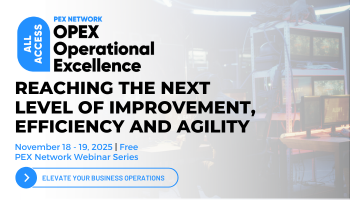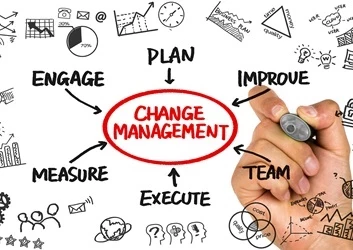Business transformation glossary: 19 change management keywords
Knowing the language of change can help leaders understand how to navigate transformation
Add bookmark
Once upon a time business transformation was a rare phenomenon or it was brought on by crisis. Now, change is the norm, and it's a constant. As a result, process excellence professionals – not to mention others in departments like Human Resources (HR) – must lead change management projects regularly. They must help employees adopt and adapt to new and advanced technologies, uncertain geopolitcal landscapes, turnover of teams and the unexpected.
Join the PEX Network community

Don't miss any news, updates or insider tips from PEX Network by getting them delivered to your inbox. Sign up to our newsletter and join our community of experts.
Learn MoreKnowing the language of change can help leaders understand how to navigate transformation. Here is a glossary of words to live by when helming change at any organization:
1. Artificial intelligence (AI)
The technology that has the perception of having the biggest impact on process excellence is artificial intelligence (AI). If nothing else, many are experimenting and pontificating about how AI will dramatically change how people live and work. Getting people to accept life with the machines can be challenging.
“It's important that users actually get over the hurdle of adopting the technology in the way that it's designed,” says Leon Ashley, senior presales consultant at WalkMe.
2. Change management
Change management processes are at the core of successful business transformation. Companies cannot have one without the other, says Laura Karpf, senior manager of change management at Sodexo.
3. Continuous improvement
Aaron Adsit, VP of sales at GBTEC, warns that those who ignore change risk being left behind or eliminated all together. He shares the example of Blockbuster video stories.
“I'm blown away that I'm growing up in a world where my seven-year-old has no idea what a Blockbuster video is. I would have never thought something like that, but again, what does it boil down to? Well, they knew. They weren't naive. They knew that that consumers wanted content at their fingertips on any device in any location, but they couldn't adapt to change fast enough," says Adsit.
“They didn't understand the processes that could drive them better business outcomes, and they didn't know where to make those operational changes. They didn't know where to double down in efficiency. They didn't know where to put improvements. They didn't know where to allocate more resources. They didn't know how to do change management behavior trainings. If you don't know how to do that in time, especially in this rapidly evolving climate, you're going to become a Blockbuster.”
4. Data
Nowadays, change management leaders have more data than ever at their fingertips. They must know how to apply it in their transformations.
“Using data for change and steering within change is quite important, and it's not being utilized across the whole landscape enough," says Yannick Stadtelmeyer, head of customer success at Userlane. "If we look, especially on the time after the first implementation, everybody has a focus during implementation to see how good are we? We crossed the finish line, but, in my opinion, there is no real finish line to change. Change is constant and all around.”
In fact, using data analytics allows leaders to better track their progress.
“The use of data and change management help to mitigate some of those risks and enable a greater chance of program success,” says Tina Cannon, change management leader at Collective Insights.
5. Digital adoption
People can be both the problem and the solution. Treat them well, however, and the positive returns begin to arrive. With all the new technology, robust digital adoption programs are the start of a beautiful relationship.
“We thought over the last five years that we had a technology problem, but actually, if you think about it, we have a change management problem,” says KJ Kusch, global field CTO at WalkMe. “So how do you overcome these challenges? It's people, not technology, who are probably interfering with your change management or your operational excellence and your success scores.”
6. Emotion
Julie Whitten, senior director change management strategy & employee communications transformation office, North America at Sodexo, shares advice on how to deal with the emotions that people feel when faced with great change (below).
7. Empathy
Michael Dove, VP, enterprise process excellence & quality at Velera, offers a moving and simple description of empathetic leadership.
8. Follow up
Change management is not a one-day affair. Leaders must be persistent and consistent. They must follow up as the transformation unfolds.
“You go down the path of a transformation. There's a beginning, and there's an end. Then everybody disperses back to where they came from essentially,” says Haywood Hamilton, partner, head of consulting services at Collective Insights. “Then you just assume that you know the technology is going to work the way that the transformation intended it. There's nobody really keeping their eyes on it.”
9. Framework
Following up requires measuring KPIs and progress, and having a structure or framework can help leaders accomplish this.
“In our opinion, you have to have a framework. That framework should help you understand your baseline and measure what you're working toward. We apply this to onboarding or implementing or just improving the utilization of technology applications," says Serge Dushkin, industry lead at Userlane.
“We actually help our customers implement a framework called HEART. The point of this is to create a consistent way of measuring how you're progressing through that change and making sure that you know all stakeholders are in line. It's an acronym for measuring the happiness, engagement, adoption, retention and task success of those areas, but each one of those categories in that framework has a goal. They have signals that they need to be able to watch out for and a lot of metrics of whether or not you're on the right track.”
10. Human-centric approach
Keeping the focus on the talent fulfilling the transformation is vital by all accounts.
“It's still about people, even though data is important. The data helps [show] leaders they have to be authentic, and how they talk about the change. Our people (all people everywhere) can spot scripted messages a mile away. They hear it in the tone. If leaders don't talk about the change in day-to-day meetings, they understand that. So it's helped us help leaders have a much more genuine, authentic approach and take more time to understand what the impacts are for them and their team, so they can talk about them sincerely and similarly, on the individual level," says Cecilia Jacob, director of strategic change management and communications, global business services, Kimberly-Clark
11. Innovation
Ishneet Kaur, director of innovation at National Grid, helps people understand the relationship between change management and innovation.
12. Jobs
Business transformation often has the greatest impact on the jobs of people. What roles will they be taking on? What will their job look like after the change? How will their day-to-day be different?
“When organizations are putting in new computer systems like that, you're changing the way people's jobs happen," says Kerry Brown, lead transformation evangelist at Celonis. "For me, my litmus test for any big transformation is really, how does somebody's job change? How do you help them get that done?”
13. Leadership
Susan Jarrell Kushnir, VP, head of investment bank talent development at Deutsche Bank explains the concept of leading with your head, heart and guts.
14. Mindset
People must flip their perception of change, says Beth Foley, senior manager, change management, transformation management office at Sodexo.
15. People
At the core of any organization and its transformation projects are the people making the magic. Isolde Kanikani, VP of the Association of Change Management Professionals (ACMP), advises leaders to keep the people as their top priority.
16. Priorities
When taking on a transformation project, particularly in a traditional company bound by regulations, leaders must set priorities from the start, says Pradheep Kileti, a director at National Grid.
17. Resilience
Adam B Schreiber, global director, change management, transformation management office at Johnson & Johnson, offers an astute description of resilience at work.
18. Transparency
Leaders often fear transparency because they don't want to show weakness, but the consensus is that the people already know the truth. They live it every day. Ryan Mayer, head of healthineer performance system, Americas at Siemens Healthineers, gets real about communication.
19. Trust
Whenever leaders ask people to overcome their fears, work outside their comfort zone and embrace and execute a dramatic change, they must ensure there is trust. Blake Hill, senior director of quality assurance & agile delivery at AccentCare, talks about how he creates a safe place for collaboration.
All Access: OPEX Operational Excellence 2025

Operational excellence is a set of practices that helps organizations to improve their efficiency and effectiveness. In 2025, operational excellence will be more important than ever as organizations look to reduce costs and improve customer satisfaction.
All Access: OPEX Operational Excellence 2025 from PEX Network will help professionals get an understanding of the latest developments in operational excellence, including how to identify and improve key processes, how to implement operational excellence initiatives, and how to measure the success of operational excellence initiatives.
Register Now

















